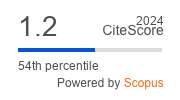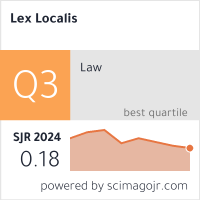Vloga zelenih financ v projektih energetskih skupnosti, ki uporabljajo obnovljive vire, v glavni regiji in Tajvanu
DOI:
https://doi.org/10.4335/19.3.503-519(2021)Ključne besede:
zeleno financiranje, množično financiranje, projekti energetskih skupnosti, ki uporabljajo obnovljive vire, finančna tehnologijaPovzetek
Da bi dosegli cilj nejedrske domovine in uresničili cilj politike, da obnovljiva energija predstavlja 20 % proizvodnje električne energije, je tajvanska vlada dejavno spodbujala integracijo proizvodnje energije. Mnoga mala in srednje velika podjetja ali zagonska podjetja se soočajo z izzivom financiranja širitve poslovanja. V tem dokumentu je bila uporabljena metoda analize dokumentov za iskanje bolj raznolikih kanalov financiranja v primerjavi s tradicionalnimi načini financiranja in posojanja finančnih institucij, kombinacija finančne tehnologije in moči množic, kot je množično financiranje, pa je postala eden od nastajajočih finančnih instrumentov za razvoj industrije zelene energije. Empirični rezultat primerjamo z glavnimi regijami glede projektov energetskih skupnosti, ki uporabljajo obnovljive vire, in ugotovimo, kako pridobiti obnovljive vire energije z novim virom financiranja. Študija bo zagotovila povezano sklicevanje na odločanje držav, ki načrtujejo razvoj projektov, ki uporabljajo obnovljive vire energije.
Literatura
Abraham, M. A. (2006) Chapter 1 Principles of sustainable engineering, Sustainability Science and Engineering, 1, pp. 3-10.
Allenby, B., Allen, D. & Davidson, C. (2007) Sustainable engineering: From myth to mechanism, Environmental Quality Management, 17, pp. 17–26.
Bocken, N, Rana, P. & Short. S. (2015) Value Mapping for Sustainable Business Thinking, Journal of Industrial and Production Engineering, 32(1), pp. 67-81.
Bowen, G. A. (2009) Document analysis as a qualitative research method, Qualitative Research Journal, 9(2), pp. 27-40.
Community wind power (2020) Citizen's windmill, http://www.h-greenfund.jp/citizn/citizn.html (accessed 13 July 2020).
Daan, R. (2018) The Smog Free Project, available at: https://www.kickstarter.com/projects/1777606920/the-smog-free-tower (July 13, 2020).
Elkington, J. B. (1997) Cannibals with Forks: The Triple Bottom Line of 21st Century (Oxford: Business Capstone Publishing).
Galema, R., Plantinga, A. & Scholtens, B. (2008) The Stocks at Stake: Return and Risk in Socially Responsible Investment, Journal of Banking and Finance, 32(12), pp. 2646-2654.
Greenpeace Energy (2020) Energy Cooperative with a Mission, available at: https://www.greenpeace-energy.de/fileadmin/docs/sonstiges/GPE_Profile_EN.pdf (July 13, 2020).
Guenster, N., Bauer, R., Derwall, J. & Koedijk, K. (2011) The Economic Value of Corporate Eco-Efficiency, European Financial Management, 17(4), pp. 679-704.
Healy, N. & Barry, J. (2017) Politicizing energy justice and energy system transitions, fossil fuel divestment and a ‘just transition’, Energy Policy, 108, pp. 451–459.
Hirst, P. (1994) Associative democracy, new forms of economic and social governance (Cambridge: Polity Press).
Hoffmann S. M. & High Pippert, A. (2015) Community solar programs and the democratization of the energy system, Proceedings of the european consortium for political research; Montreal, QC, Canada, 26–29 August 2015, available at: https://ecpr.eu/Filestore/PaperProposal/8ac09b8b-ed 6e-4798-b1ed-6975c7172230.pdf. (June 30, 2020).
Larsen, J. H. M., Soerensen, H. K., Christiansen, E. & Naef, S. (2005) Experiences from Middelgrunden 40 MW Offshore Wind Farm, Copenhagen Offshore Wind, October 26-28.
New Urban Energy (2020) Grenoble’s energy master plan: less waste, more renewable, available at: http://www.cityzen-smartcity.eu/grenobles-energy-master-plan-less-waste-more-renewable/ (July 13, 2020).
Ning, Y., Wang, W. & Yu, B. (2015) The driving forces of venture capital investments, Small Business Economics. 44(2), pp. 315–344.
Noothout, P., de Jager, D., Tesniere, L., van Rooijen, S., Nikolaos, K., Bruckmann, R., Jirous, F., Breitschopf, B., Angelopoulos, D., Doukas, H., Konstantinaviciute, I. & Resch, G. (2016) The impact of risks in renewable energy investments and the role of smart policies. DiaCore Project Final Report.
Origis Energy (2020) Innovative Solutions for High Performing Solar Energy Assets, available at: https://www.origisenergy.com/solar-projects/ (July 13, 2020).
Plattform Energie (2015) Market integration and the development of wind power cooperatives in Denmark lessons learned for Germany, available at: https://www.iass-potsdam.de/sites/default/files/files/20150217_market_integration_gotchev.pdf (July 13, 2020).
Raiffeisenbank eG Scharrel (2013) Saterland wind farm, available at: https://www.rbscharrel.de/wir-fuer-sie/engagement/windenergie-in-buergerhand/windpark-saterland.html (July 13, 2020).
Laws and Regulations Database of The Republic of China (2019) Renewable Energy Development Act, available at: https://law.moj.gov.tw/Eng/LawClass/LawAll.aspx?PCODE=J0130032 (March 20, 2021).
Schueth, S. (2003) Socially responsible investing in the United States, Journal of Business Ethics, 3(3), pp. 189-194.
Taiwan News (2020) Taiwan to boost renewable energy to 20% by 2025, introduce trillion-dollar investment, available at: https://www.taiwannews.com.tw/en/news/3880997 (July 13, 2020).
Van Veelen, B. & Van der Horst, D. (2018) What is energy democracy? Connecting social science energy research and political theory, Energy Research Society Science, 46, pp. 19–28.
Vismara, S. (2019) Sustainability in Equity Crowdfunding, Technological Forecasting and Social Change, 141(2), pp. 98-106.
Wu, S., Yao, X. & Wu, g. (2020) Environmental Investment Decision of Green Supply Chain considering the Green Uncertainty, Complexity, 13, https://doi.org/10.1155/2020/8871901.








